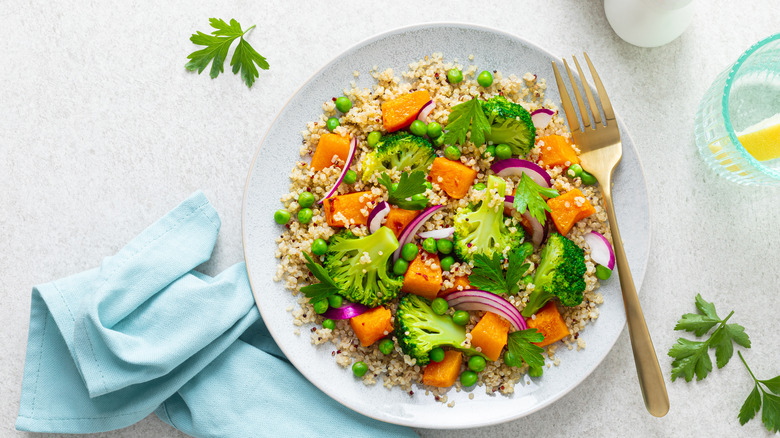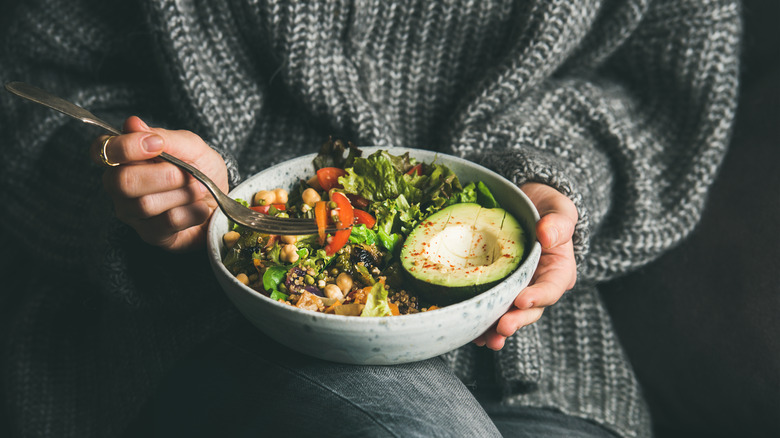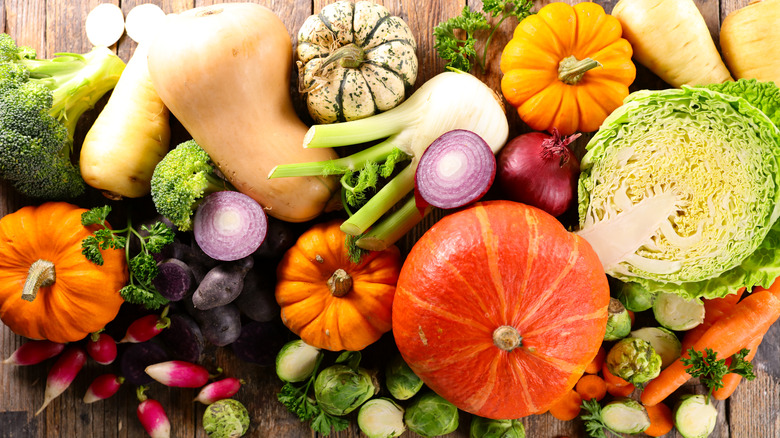Instagram's 'Baked Salad' Trend, Explained
Salads might be the original health food. What could be more simple, nutritious, and colorful than a big bowl of vegetables? Salads are widely available — on restaurant menus, sold premixed in bags at the supermarket, and easy to make at home. Salads can be appetizers, side dishes, the main course, or palate cleansers — in Italy, they're traditionally eaten after a rich meal (per Italian Garden). While a classic Caesar and a mayo-laden bowl of boiled eggs can be called salad, the word comes from the 14th-century salade, meaning "raw herbs cut up and variously dressed," and the Latin saltata for "salted," per Etymology Online.
But there are some things about salads that are decidedly less than wholesome. For one, fresh, quality produce is unavailable in all areas year-round, and relying on what's grown outside your region comes with a sizable carbon footprint. Also, some folks have trouble with raw vegetables — whether it's a matter of personal preference or unpleasant digestive issues due to all the fiber and phytochemicals (per Insider). Fortunately, the internet has spawned a food trend that can help you make the most of what's growing near you and keep you scarfing down salads 365 days a year. Enter: the baked salad.
Much better than it sounds
A baked salad sounds like an oxymoron. After all, salads are usually eaten cold, with mainly uncooked ingredients: leafy greens, cut-up vegetables, some fruit, and nuts if you're inclined. Putting a bunch of spring mix in the oven would make it unappetizing. So what's a baked salad? Cook and TikTok user Justine Doiron posted an Instagram video about her baked kale and crispy quinoa salad. She says it's made with "warm honey-vinegar dressing, slightly charred cabbage and spicy puffed quinoa, roasted in the oven and thrown into warm-salad-heaven." Color us intrigued.
During a time of year when delicate lettuce can only grow in a warm place (like a greenhouse or California), hearty greens like kale make more-than-worthy substitutes. Kale and its relatives not only withstand cold temperatures, they actually become more flavorful after they've weathered a few frosts (per Michigan State University). Kale, like many greens, is also fibrous and tough; cooking makes it easier for the body to process. In fact, with the proper methods, cooked vegetables can offer more nutrients than raw ones, according to Healthline.
Baked salad at home
So how can you hop on the baked salad bandwagon? Justine Doiron shouts out cabbage and chard, which come in such stunning varieties, you really have no excuse not to try them. Foodprint explains that during the fall and winter, you can also find alliums (onions and the like), root crops (like carrots and beets), and brassicas — a diverse and delicious family that includes broccoli, cauliflower, Brussels sprouts, turnips, radishes, kohlrabi, bok choy, and collard greens, to name a few (per MasterClass).
Foodprint reminds us that during the slow-growing season from November to April, farmers benefit from the additional revenue that winter crops bring in. For the eater, they offer a wide array of nutrients, colors, tastes, and textures to dazzle your palate and draw you out of cabin fever and into the kitchen.
For inspiration, why not try Ree Drummond's ultimate winter salad with the sweet and nutty crunch of pecans and pomegranate? Or her sheet-pan salad, highlighting the wonderful flavor of delicata squash paired with goat cheese and rich tahini? Giada De Laurentiis's beet and burrata salad uses champagne vinegar and toasted pine nuts. You can't go wrong with Martha Stewart's many ideas for collard greens, pairing with everything from bacon to coconut. Use these salads as side dishes, or bump up the protein to make them the entrée. Baked salads are the perfect way to eat seasonally, beat the winter blues, and support who grows your food.


